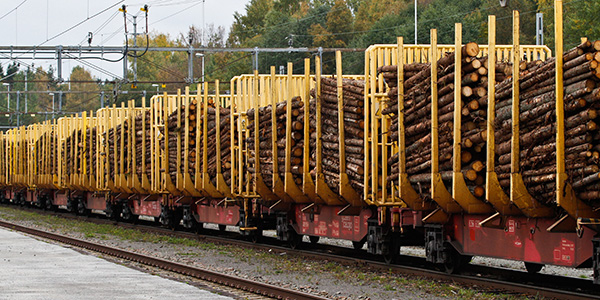Freight transport accounts for a large proportion of the emissions, noise and congestion produced by road traffic. Transporting freight in larger but fewer lorries could reduce the problem. At the same time it might entail freight being diverted from more environmentally beneficial modes of transport such as rail and sea.

Overall, an increased proportion of freight was transported by rail after 2000. Inge Vierth feels that certain external circumstances have affected the type of transport. Photo: Mostphotos
Post analysis of Freight Modal split is a VTI (Swedish National Road and Transport Research Institute) analysis of how domestic freight has historically been influenced by an increase in permissible size of road haulage vehicles. Longer and heavier vehicles increase the possibilities of transporting larger amounts of freight per shipment and produce lower emissions and costs per tonne kilometre*.
“Sweden and Finland are the leading countries in Europe for heavy vehicles. We have had considerably heavier lorries than the rest of EU for some time ,” says Inge Vierth, who is leading the investigation at VTI. “The maximum weight in Sweden is 64 tonnes, and in Finland it totals 76 tonnes, which can be compared with the rest of the EU, where lorries can weigh a maximum of 40 tonnes.”
However, there are now signs indicating that the 40 tonne limit in the rest of the EU countries will be raised. This might entail problems, as heavier lorries represent a competitive advantage for road haulage. Companies which currently transport freight by rail, which has less of an impact on the climate, could thus instead be attracted to road transport.
Moving from trains to lorries
In order to evaluate the companies’ inclination to move to lorries, VTI’s study has examined what happened on the occasions when Sweden raised the maximum permitted weights for lorry rigs in 1990 and 1993.
Both Sweden and the EU have an ambition to keep long distance freight on rail – however, transporting freight over short distances by train is difficult. Inge Vierth considers that the different character of the freight also produces different conditions. “In Germany and France, for example, a larger proportion of light goods is transported than in Sweden and Finland, where a large proportion of the heavy shipments consist of timber, steel and iron ore.”
The conditions are consequently not entirely comparable between, for example, Germany and Sweden. Furthermore, according to Inge Vierth, it is difficult to draw clear conclusions from the Swedish conditions in 1990 and 1993 – a period that was strongly characterised by economic crises. “Despite the increase in the maximum permitted weight of road vehicles, we don’t see any clear move away from rail, even though road haulage benefited from an expanding market during the 1990s.”
Timber transported on road
Overall, an increased proportion of freight was transported by rail after 2000. Inge Vierth feels that certain external circumstances have affected the type of transport. For example, an increasing proportion of round timber went over to road transport during the 1990s. However, there was a rise in transport of round timber by rail in connection with storm Gudrun in 2005. “Such large amounts of round timber were involved that more rail transport became necessary and rail has subsequently increased its share of timber transport.”
According to the study, transfer of freight from one kind of transport to another is partly down to which type of goods it concerns. “Heavy goods such as paper and cardboard are difficult to switch over from rail to road, but wood products, for example, have largely changed from rail to road.
Inge Vierth also observes that rail has taken market shares during the last decade, which is partly due to the fact that transport customers have adapted and developed smarter systems. “For example, ICA and SSAB are collaborating. The trains are full in both directions, which is a good thing.”
Text: Johan Granath/redakta
*unit of weight times distance driven
 Contact
Contact
Inge Vierth
inge.vierth@vti.se
VTI, Sweden






Follow us: